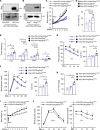LepRb+ cell-specific deletion of Slug mitigates obesity and nonalcoholic fatty liver disease in mice
- PMID: 36512408
- PMCID: PMC9927931
- DOI: 10.1172/JCI156722
LepRb+ cell-specific deletion of Slug mitigates obesity and nonalcoholic fatty liver disease in mice
Abstract
Leptin exerts its biological actions by activating the long-form leptin receptor (LepRb). LepRb signaling impairment and leptin resistance are believed to cause obesity. The transcription factor Slug - also known as Snai2 - recruits epigenetic modifiers and regulates gene expression by an epigenetic mechanism; however, its epigenetic action has not been explored in leptin resistance. Here, we uncover a proobesity function of neuronal Slug. Hypothalamic Slug was upregulated in obese mice. LepRb+ cell-specific Slug-knockout (SlugΔLepRb) mice were resistant to diet-induced obesity, type 2 diabetes, and liver steatosis and experienced decreased food intake and increased fat thermogenesis. Leptin stimulated hypothalamic Stat3 phosphorylation and weight loss to a markedly higher level in SlugΔLepRb than in Slugfl/fl mice, even before their body weight divergence. Conversely, hypothalamic LepRb+ neuron-specific overexpression of Slug, mediated by AAV-hSyn-DIO-Slug transduction, induced leptin resistance, obesity, and metabolic disorders in mice on a chow diet. At the genomic level, Slug bound to and repressed the LepRb promoter, thereby inhibiting LepRb transcription. Consistently, Slug deficiency decreased methylation of LepRb promoter H3K27, a repressive epigenetic mark, and increased LepRb mRNA levels in the hypothalamus. Collectively, these results unravel what we believe to be a previously unrecognized hypothalamic neuronal Slug/epigenetic reprogramming/leptin resistance axis that promotes energy imbalance, obesity, and metabolic disease.
Keywords: Cell Biology; Diabetes; Leptin; Metabolism; Obesity.
Conflict of interest statement
Figures







References
Publication types
MeSH terms
Substances
Grants and funding
LinkOut - more resources
Full Text Sources
Medical
Molecular Biology Databases
Research Materials
Miscellaneous

